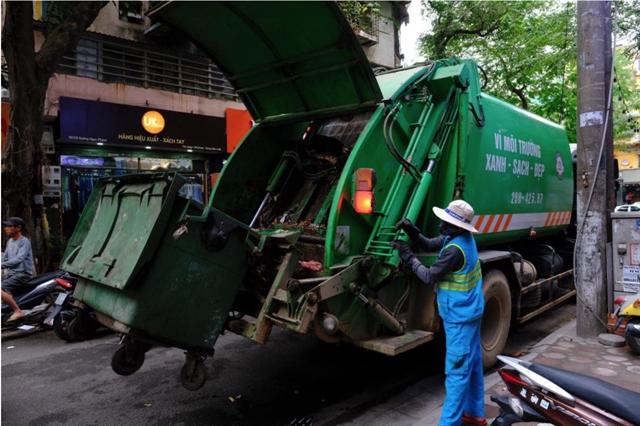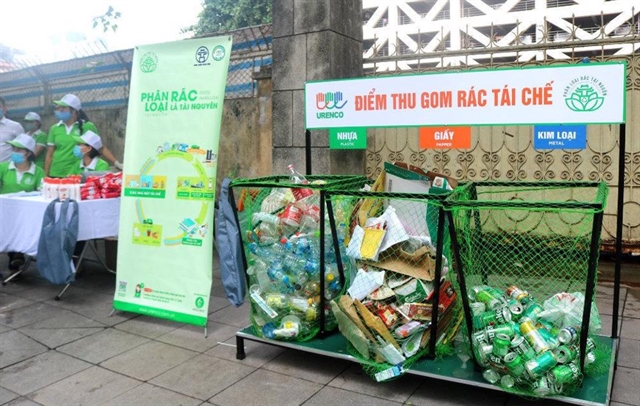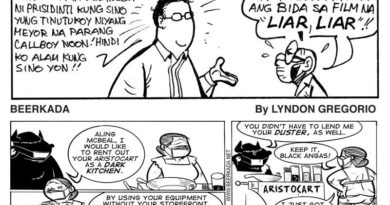SOLID WASTE MGMT | Hà Nội needs solution for sorting solid waste at source

HÀ NỘI — The problem of domestic solid waste treatment is a challenge for the sustainable development of Hà Nội.Article 79 of the Law on Environmental Protection in 2020 stipulates that localities must classify domestic solid waste discharged from households and individuals by December 31, 2024.
The deadline is less than two years away, but localities are still struggling to find the appropriate plan.
Lack of guidance
Up to now, the Ministry of Natural Resources and Environment (MONRE) has not yet issued specific guidance for cities and provinces nationwide.
The Law on Environmental Protection regulates the classification of solid waste into three categories of recyclable solid waste, food waste and other domestic solid waste.
Hà Nội is the second largest city in the country with an estimated population of more than nine million people who discharge about 7,000 tonnes of domestic solid waste per day that needs to be treated.
According to statistics, among the 7,000 tonnes of daily domestic solid waste, food waste accounts for 51.9 per cent, equal to 3,600 tonnes, inert substances such as leather, wood and rubber account for 38 per cent (about 2,700 tonnes), and recyclable solid waste is 7.1 per cent (about 500 tonnes).
Currently, 98 per cent of domestic solid waste is collected and dumped in landfills, while only 2 per cent of domestic solid waste is treated by burning.
Therefore, the treatment of domestic solid waste becomes a vital issue for the sustainable development of the city.
The classification of domestic waste has been piloted since 2006. At that time, the city carried out a pilot project of waste separation at source, known as project 3R funded by the Japan International Co-operation Agency (JICA).
With the aim to reduce, recycle and reuse waste, the project achieved many remarkable results.
After the pilot period, the amount of waste sent to landfills decreased by 30 per cent, which helped reduce environmental pollution, save waste treatment costs and extend the life of landfills.
However, in just three years, the project had to stop because JICA stopped funding the programme.
Currently, most dust bins in streets are too small so garbage is always overflowing out while garbage trucks are too old so garbage water flows into the street. Moreover, there are no separate vehicles for separate types of waste.
Three main pillars
 |
| Garbage collection in Đống Đa District. — Photo kinhtedothi.vn |
According to Dr. Nguyễn Huy Nga, Hà Nội needs synchronous solutions to meet the requirements of solid domestic waste treatment.
First of all, the city must identify the main solid waste treatment technologies in coming years so that on that basis it can take appropriate classification measures.
For example, it must classify what food waste should be composted or buried, what type of solid waste should be burned to generate electricity to avoid the situation where garbage collection workers mix waste together for treatment because there is no place to treat each type of waste separately.
The city must quickly issue technical guidelines on waste segregation at source and make them widely available. It is possible to implement a pilot programme at some places and then replicate it to the whole city.
It is necessary to offer a financial mechanism to encourage recycling activities, such as a tax reduction, or land policies to build recycling factories.
There is a need, especially within the private sector, to invest in waste sorting equipment at source.
According to Nga, the city should provide households garbage bags and trash cans which have specific colours for each type of waste so that they can sort waste at home.
The most important factor for solid waste segregation at source is to raise public awareness.
One of the main reasons for the failure of pilot projects of sorting waste at source is that people are not aware of their important contribution to the city’s environmental protection and garbage classification.
Therefore, when the project stops being financed, the waste sorting work at the source automatically ends.
Education and communication to raise people’s awareness must be carried out regularly with the participation of local governments and civil organisations. Schools need to teach students how to separate waste at source so that they can apply it at home.
The arrangement of garbage disposal also needs to be specified, appropriate and notified to each family. The experience of other cities shows that it is possible to arrange for sorting garbage at home according to the days of the week.
For example, recyclable waste on Mondays, food waste daily, and hazardous waste on a certain day of the month.
In summary, in order to meet the requirement of waste separation at source of the Law on Environmental Protection, it was important that the municipal authority firmly establish the three main pillars of technical infrastructure, raising awareness of households and strict enforcement of the law and sanctions, Nga said. — VNS


 Memento Maxima Digital Marketing
Memento Maxima Digital Marketing Ads by: Memento Maxima Digital Marketing
Ads by: Memento Maxima Digital Marketing






